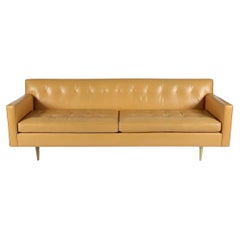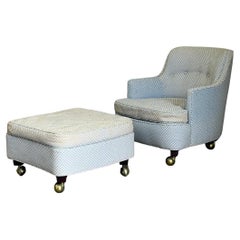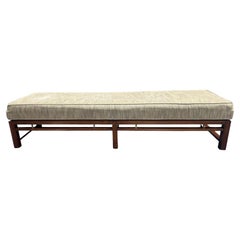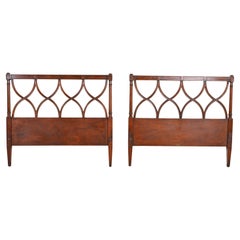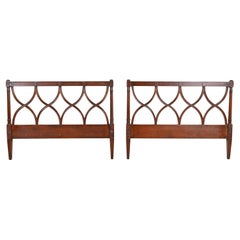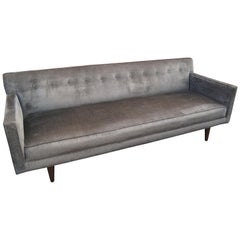Dunbar
Revered for its handcrafted and highly collectible mid-century modern sofas, coffee tables and other furnishings, Dunbar Furniture was founded in 1910 in Berne, Indiana, but it didn’t gain widespread recognition until the ’30s, following the introduction of its president to a designer who would leave an indelible mark on the company’s legacy: Edward Wormley.
After a stint at the Art Institute of Chicago, the Oswego, Illinois-born Wormley worked as an interior designer for Marshall Field’s before joining Dunbar in 1931. Initially focused on developing the company’s cheapest furniture line, which could be bought with soap coupons, he was soon leading Dunbar Furniture into a new era of residential furniture for modern American homes. He would serve as the company’s design director for over three decades, designing about 150 pieces each year.
During that time, he oversaw the production of designs in a wide range of materials, with influences ranging from Scandinavian modernism to Art Deco. There were modern upholstery pieces, like swiveling lounge chairs and low-slung sofas, and experiments with textural wood on bar carts and cabinets as well as minimal, sculptural tables and functional office furniture. A passionate collector of Tiffany Studios lamps, Wormley used their glass tiles in Dunbar tables in 1956. He also worked on the reproduction of pieces by designers such as Jean-Michel Frank and Richard Riemerschmid.
One standout Dunbar Furniture collection was Janus, introduced in the 1960s, with Austrian-born ceramicists Otto and Gertrud Natzler. These pieces see the Natzlers’ uniquely artful ceramic tiles set into several styles of wooden tables. They remain some of the most sought-after mid-century modern Dunbar pieces on the vintage market today. During the peak of his design career and, indeed, the height of Dunbar Furniture’s history, Wormley amassed a whopping 30 Good Design awards between 1950 and 1955 through the “Good Design” exhibition, hosted by the Chicago Merchandise Mart and the Museum of Modern Art. Dunbar today produces a limited selection of archival Wormley designs, but many sales of original Dunbar pieces are through the resale market.
Find a collection of authentic vintage Dunbar Furniture today on 1stDibs.
| Average Sold Price |
| $4,472 |
| Styles |
| Materials |
| Related Creators |
1960s American Mid-Century Modern Vintage Dunbar
Brass
1960s American Mid-Century Modern Vintage Dunbar
Wrought Iron
1950s American Mid-Century Modern Vintage Dunbar
Velvet, Walnut
1950s American Mid-Century Modern Vintage Dunbar
Brass
1940s American Louis XVI Vintage Dunbar
Mahogany
1970s American Mid-Century Modern Vintage Dunbar
Upholstery, Wood
1940s American Louis XVI Vintage Dunbar
Mahogany
1950s American Mid-Century Modern Vintage Dunbar
Upholstery, Walnut
Dunbar Sale Prices
| Sold Date | Sold Price | Category | Material | Creation Year | ||||||||||||||||||||||||||||||||||||||||||||||||||||||||||||||||||||||||||||||||||||||||||||||||
|
| $4,472 |
Average sold price of items in the past 12 months |
| $225-$15,600 |
| Sold price range of items in the past 12 months |
Creators Similar to Dunbar
Dunbar furniture for sale on 1stDibs.
- Where is Dunbar Furniture made?1 Answer1stDibs ExpertMarch 22, 2022Dunbar furniture is made in High Point, North Carolina. The original location of the company was Berne, Indiana. Its relocation occurred after Currey & Co. bought Dunbar from founder James Wormley in 1970. On 1stDibs, shop a selection of Dunbar furniture.
- 1stDibs ExpertSeptember 23, 2024To identify Dunbar furniture, search your piece for maker's markings. Some pieces feature a D-shaped metal tag, while others bear a metal plaque with the brand name etched on its surface, with or without the company's location: Berne, Indiana. Dunbar also branded its name onto the wood frames of certain furnishings. Upholstered pieces will most likely have the brand name on a label sewn onto a cushion. If you have difficulty locating a maker's mark, a certified appraiser or knowledgeable antique dealer will assist you. Shop a variety of Dunbar furniture on 1stDibs.
